BSB80615 Graduate Diploma: Networking and Partnerships Assessment
VerifiedAdded on 2020/04/29
|19
|4859
|156
Homework Assignment
AI Summary
This document presents a comprehensive solution to an assessment on networking and partnerships, designed for the BSB80615 Graduate Diploma of Management (Learning) unit BSBLDR803. The assessment comprises two main parts. The first part, Assessment 1, focuses on networking, covering the differences between operational, personal, and strategic networking, the benefits of networking, the roles of clusters and brokers, the importance of networking outside one's organization, and the concept of an 'elevator pitch.' It includes a practical activity where students are required to structure their own networks across various timeframes, and engage with LinkedIn. The second part, Assessment 2, delves into networking and partnerships, exploring Alan Fowler's five relationship typologies, the definition of a partnership, partnership principles (equity, transparency, and mutual benefit), key characteristics of effective relationships, barriers to successful partnerships, emotional intelligence and its impact on individual and team effectiveness, and organizational transformation within the context of partnership formation. The assessment requires candidates to answer detailed questions based on provided readings, demonstrating their understanding of the theoretical concepts and their ability to apply them in practical scenarios.
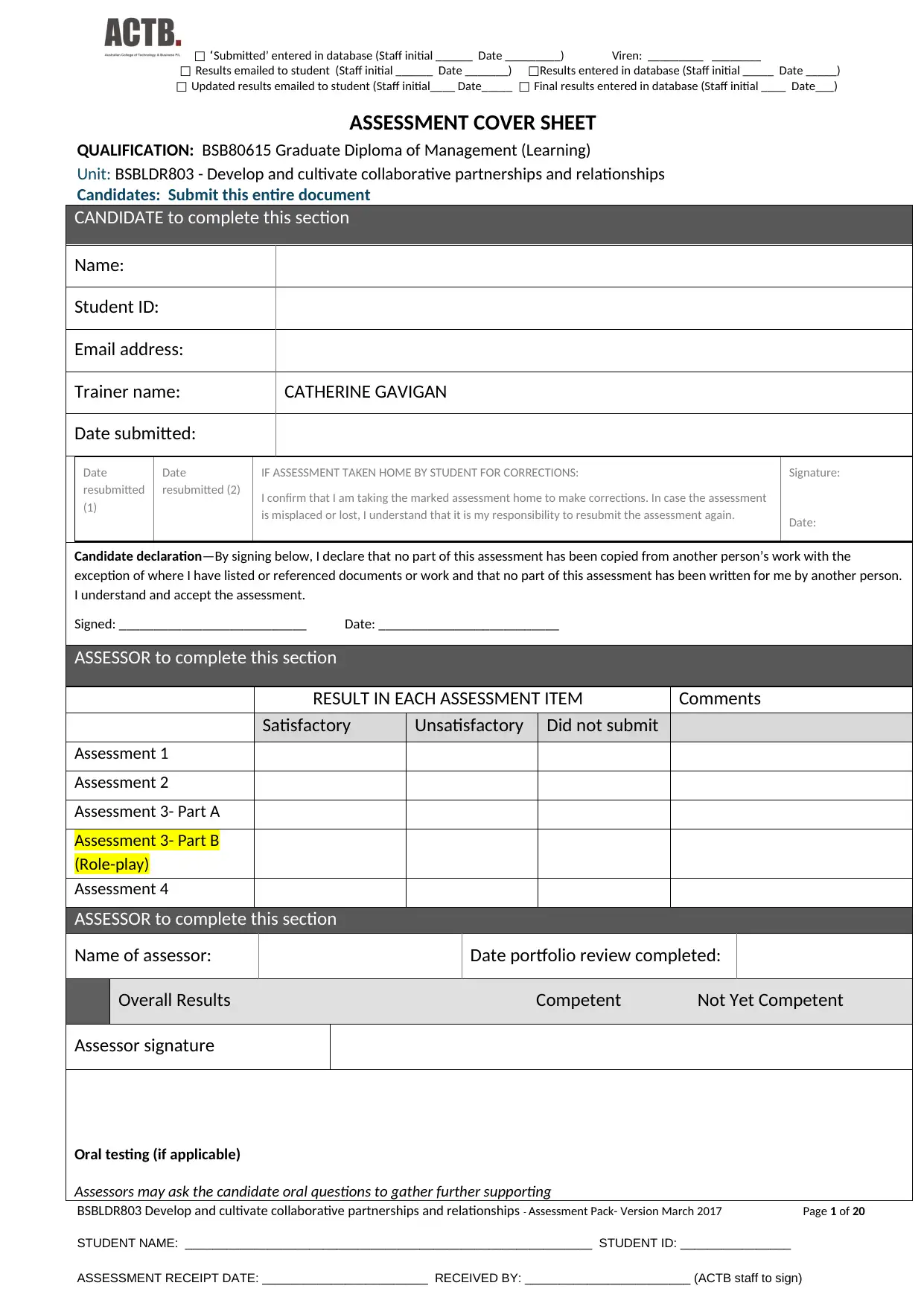
□ ‘Submitted’ entered in database (Staff initial ______ Date _________) Viren: _________ ________
□ Results emailed to student (Staff initial ______ Date _______) □Results entered in database (Staff initial _____ Date _____)
□ Updated results emailed to student (Staff initial____ Date_____ □ Final results entered in database (Staff initial ____ Date___)
ASSESSMENT COVER SHEET
QUALIFICATION: BSB80615 Graduate Diploma of Management (Learning)
Unit: BSBLDR803 - Develop and cultivate collaborative partnerships and relationships
Candidates: Submit this entire document
CANDIDATE to complete this section
Name:
Student ID:
Email address:
Trainer name: CATHERINE GAVIGAN
Date submitted:
Date
resubmitted
(1)
Date
resubmitted (2)
IF ASSESSMENT TAKEN HOME BY STUDENT FOR CORRECTIONS:
I confirm that I am taking the marked assessment home to make corrections. In case the assessment
is misplaced or lost, I understand that it is my responsibility to resubmit the assessment again.
Signature:
Date:
Candidate declaration—By signing below, I declare that no part of this assessment has been copied from another person’s work with the
exception of where I have listed or referenced documents or work and that no part of this assessment has been written for me by another person.
I understand and accept the assessment.
Signed: ___________________________ Date: __________________________
ASSESSOR to complete this section
RESULT IN EACH ASSESSMENT ITEM Comments
Satisfactory Unsatisfactory Did not submit
Assessment 1
Assessment 2
Assessment 3- Part A
Assessment 3- Part B
(Role-play)
Assessment 4
ASSESSOR to complete this section
Name of assessor: Date portfolio review completed:
Overall Results Competent Not Yet Competent
Assessor signature
Oral testing (if applicable)
Assessors may ask the candidate oral questions to gather further supporting
BSBLDR803 Develop and cultivate collaborative partnerships and relationships - Assessment Pack- Version March 2017 Page 1 of 20
STUDENT NAME: ___________________________________________________________ STUDENT ID: ________________
ASSESSMENT RECEIPT DATE: ________________________ RECEIVED BY: ________________________ (ACTB staff to sign)
□ Results emailed to student (Staff initial ______ Date _______) □Results entered in database (Staff initial _____ Date _____)
□ Updated results emailed to student (Staff initial____ Date_____ □ Final results entered in database (Staff initial ____ Date___)
ASSESSMENT COVER SHEET
QUALIFICATION: BSB80615 Graduate Diploma of Management (Learning)
Unit: BSBLDR803 - Develop and cultivate collaborative partnerships and relationships
Candidates: Submit this entire document
CANDIDATE to complete this section
Name:
Student ID:
Email address:
Trainer name: CATHERINE GAVIGAN
Date submitted:
Date
resubmitted
(1)
Date
resubmitted (2)
IF ASSESSMENT TAKEN HOME BY STUDENT FOR CORRECTIONS:
I confirm that I am taking the marked assessment home to make corrections. In case the assessment
is misplaced or lost, I understand that it is my responsibility to resubmit the assessment again.
Signature:
Date:
Candidate declaration—By signing below, I declare that no part of this assessment has been copied from another person’s work with the
exception of where I have listed or referenced documents or work and that no part of this assessment has been written for me by another person.
I understand and accept the assessment.
Signed: ___________________________ Date: __________________________
ASSESSOR to complete this section
RESULT IN EACH ASSESSMENT ITEM Comments
Satisfactory Unsatisfactory Did not submit
Assessment 1
Assessment 2
Assessment 3- Part A
Assessment 3- Part B
(Role-play)
Assessment 4
ASSESSOR to complete this section
Name of assessor: Date portfolio review completed:
Overall Results Competent Not Yet Competent
Assessor signature
Oral testing (if applicable)
Assessors may ask the candidate oral questions to gather further supporting
BSBLDR803 Develop and cultivate collaborative partnerships and relationships - Assessment Pack- Version March 2017 Page 1 of 20
STUDENT NAME: ___________________________________________________________ STUDENT ID: ________________
ASSESSMENT RECEIPT DATE: ________________________ RECEIVED BY: ________________________ (ACTB staff to sign)
Paraphrase This Document
Need a fresh take? Get an instant paraphrase of this document with our AI Paraphraser
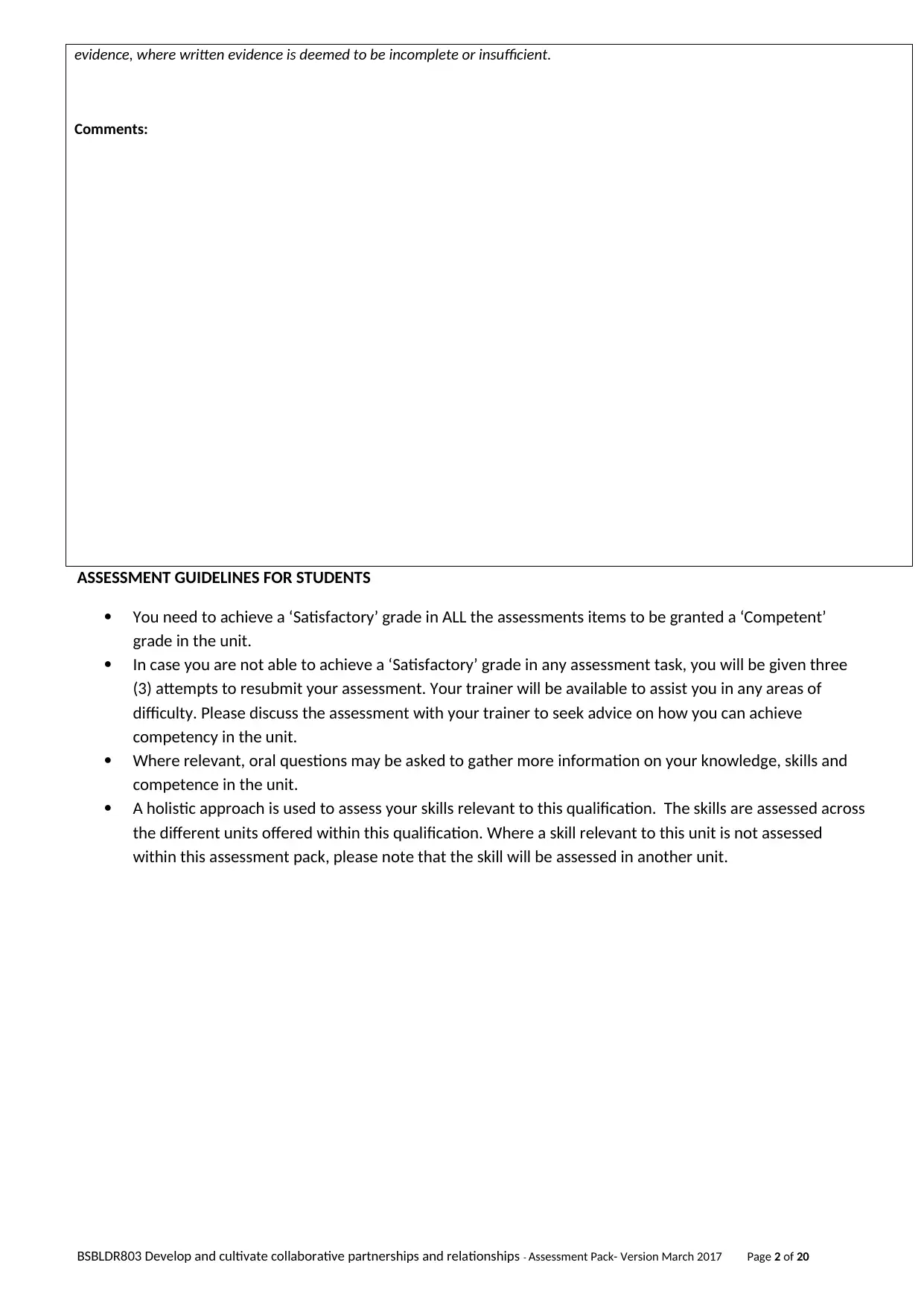
evidence, where written evidence is deemed to be incomplete or insufficient.
Comments:
ASSESSMENT GUIDELINES FOR STUDENTS
You need to achieve a ‘Satisfactory’ grade in ALL the assessments items to be granted a ‘Competent’
grade in the unit.
In case you are not able to achieve a ‘Satisfactory’ grade in any assessment task, you will be given three
(3) attempts to resubmit your assessment. Your trainer will be available to assist you in any areas of
difficulty. Please discuss the assessment with your trainer to seek advice on how you can achieve
competency in the unit.
Where relevant, oral questions may be asked to gather more information on your knowledge, skills and
competence in the unit.
A holistic approach is used to assess your skills relevant to this qualification. The skills are assessed across
the different units offered within this qualification. Where a skill relevant to this unit is not assessed
within this assessment pack, please note that the skill will be assessed in another unit.
BSBLDR803 Develop and cultivate collaborative partnerships and relationships - Assessment Pack- Version March 2017 Page 2 of 20
Comments:
ASSESSMENT GUIDELINES FOR STUDENTS
You need to achieve a ‘Satisfactory’ grade in ALL the assessments items to be granted a ‘Competent’
grade in the unit.
In case you are not able to achieve a ‘Satisfactory’ grade in any assessment task, you will be given three
(3) attempts to resubmit your assessment. Your trainer will be available to assist you in any areas of
difficulty. Please discuss the assessment with your trainer to seek advice on how you can achieve
competency in the unit.
Where relevant, oral questions may be asked to gather more information on your knowledge, skills and
competence in the unit.
A holistic approach is used to assess your skills relevant to this qualification. The skills are assessed across
the different units offered within this qualification. Where a skill relevant to this unit is not assessed
within this assessment pack, please note that the skill will be assessed in another unit.
BSBLDR803 Develop and cultivate collaborative partnerships and relationships - Assessment Pack- Version March 2017 Page 2 of 20
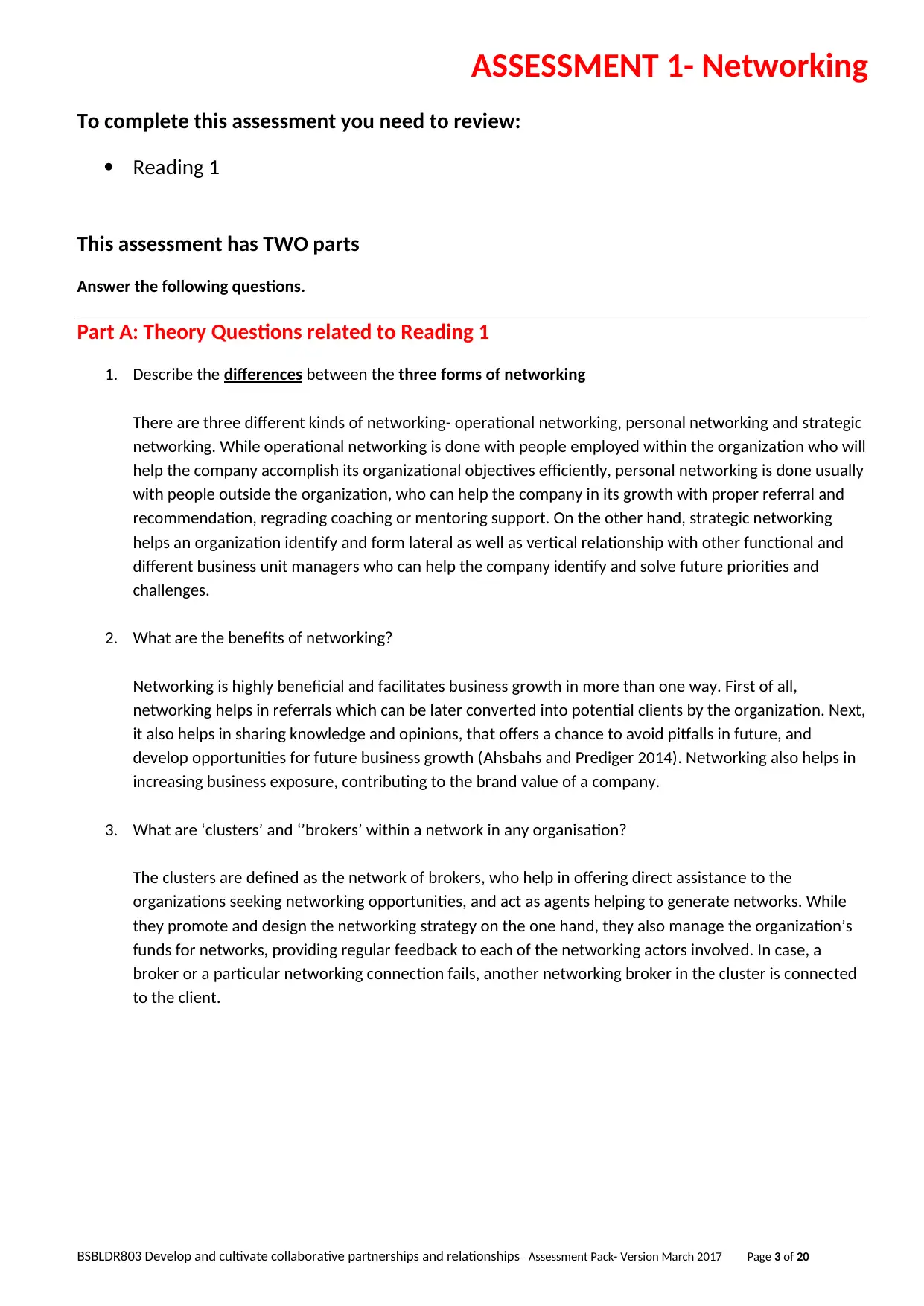
ASSESSMENT 1- Networking
To complete this assessment you need to review:
Reading 1
This assessment has TWO parts
Answer the following questions.
Part A: Theory Questions related to Reading 1
1. Describe the differences between the three forms of networking
There are three different kinds of networking- operational networking, personal networking and strategic
networking. While operational networking is done with people employed within the organization who will
help the company accomplish its organizational objectives efficiently, personal networking is done usually
with people outside the organization, who can help the company in its growth with proper referral and
recommendation, regrading coaching or mentoring support. On the other hand, strategic networking
helps an organization identify and form lateral as well as vertical relationship with other functional and
different business unit managers who can help the company identify and solve future priorities and
challenges.
2. What are the benefits of networking?
Networking is highly beneficial and facilitates business growth in more than one way. First of all,
networking helps in referrals which can be later converted into potential clients by the organization. Next,
it also helps in sharing knowledge and opinions, that offers a chance to avoid pitfalls in future, and
develop opportunities for future business growth (Ahsbahs and Prediger 2014). Networking also helps in
increasing business exposure, contributing to the brand value of a company.
3. What are ‘clusters’ and ‘’brokers’ within a network in any organisation?
The clusters are defined as the network of brokers, who help in offering direct assistance to the
organizations seeking networking opportunities, and act as agents helping to generate networks. While
they promote and design the networking strategy on the one hand, they also manage the organization’s
funds for networks, providing regular feedback to each of the networking actors involved. In case, a
broker or a particular networking connection fails, another networking broker in the cluster is connected
to the client.
BSBLDR803 Develop and cultivate collaborative partnerships and relationships - Assessment Pack- Version March 2017 Page 3 of 20
To complete this assessment you need to review:
Reading 1
This assessment has TWO parts
Answer the following questions.
Part A: Theory Questions related to Reading 1
1. Describe the differences between the three forms of networking
There are three different kinds of networking- operational networking, personal networking and strategic
networking. While operational networking is done with people employed within the organization who will
help the company accomplish its organizational objectives efficiently, personal networking is done usually
with people outside the organization, who can help the company in its growth with proper referral and
recommendation, regrading coaching or mentoring support. On the other hand, strategic networking
helps an organization identify and form lateral as well as vertical relationship with other functional and
different business unit managers who can help the company identify and solve future priorities and
challenges.
2. What are the benefits of networking?
Networking is highly beneficial and facilitates business growth in more than one way. First of all,
networking helps in referrals which can be later converted into potential clients by the organization. Next,
it also helps in sharing knowledge and opinions, that offers a chance to avoid pitfalls in future, and
develop opportunities for future business growth (Ahsbahs and Prediger 2014). Networking also helps in
increasing business exposure, contributing to the brand value of a company.
3. What are ‘clusters’ and ‘’brokers’ within a network in any organisation?
The clusters are defined as the network of brokers, who help in offering direct assistance to the
organizations seeking networking opportunities, and act as agents helping to generate networks. While
they promote and design the networking strategy on the one hand, they also manage the organization’s
funds for networks, providing regular feedback to each of the networking actors involved. In case, a
broker or a particular networking connection fails, another networking broker in the cluster is connected
to the client.
BSBLDR803 Develop and cultivate collaborative partnerships and relationships - Assessment Pack- Version March 2017 Page 3 of 20
⊘ This is a preview!⊘
Do you want full access?
Subscribe today to unlock all pages.

Trusted by 1+ million students worldwide
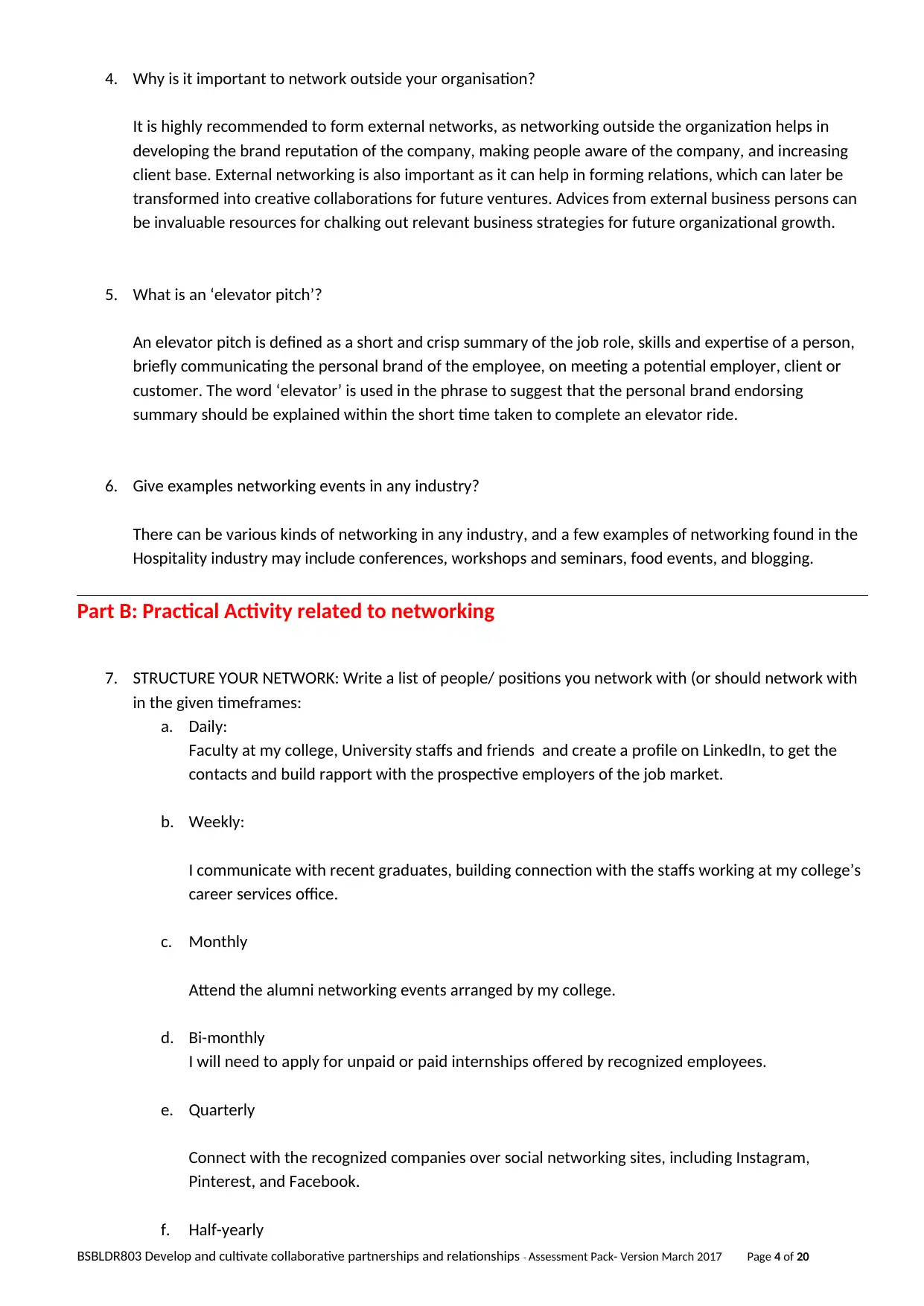
4. Why is it important to network outside your organisation?
It is highly recommended to form external networks, as networking outside the organization helps in
developing the brand reputation of the company, making people aware of the company, and increasing
client base. External networking is also important as it can help in forming relations, which can later be
transformed into creative collaborations for future ventures. Advices from external business persons can
be invaluable resources for chalking out relevant business strategies for future organizational growth.
5. What is an ‘elevator pitch’?
An elevator pitch is defined as a short and crisp summary of the job role, skills and expertise of a person,
briefly communicating the personal brand of the employee, on meeting a potential employer, client or
customer. The word ‘elevator’ is used in the phrase to suggest that the personal brand endorsing
summary should be explained within the short time taken to complete an elevator ride.
6. Give examples networking events in any industry?
There can be various kinds of networking in any industry, and a few examples of networking found in the
Hospitality industry may include conferences, workshops and seminars, food events, and blogging.
Part B: Practical Activity related to networking
7. STRUCTURE YOUR NETWORK: Write a list of people/ positions you network with (or should network with
in the given timeframes:
a. Daily:
Faculty at my college, University staffs and friends and create a profile on LinkedIn, to get the
contacts and build rapport with the prospective employers of the job market.
b. Weekly:
I communicate with recent graduates, building connection with the staffs working at my college’s
career services office.
c. Monthly
Attend the alumni networking events arranged by my college.
d. Bi-monthly
I will need to apply for unpaid or paid internships offered by recognized employees.
e. Quarterly
Connect with the recognized companies over social networking sites, including Instagram,
Pinterest, and Facebook.
f. Half-yearly
BSBLDR803 Develop and cultivate collaborative partnerships and relationships - Assessment Pack- Version March 2017 Page 4 of 20
It is highly recommended to form external networks, as networking outside the organization helps in
developing the brand reputation of the company, making people aware of the company, and increasing
client base. External networking is also important as it can help in forming relations, which can later be
transformed into creative collaborations for future ventures. Advices from external business persons can
be invaluable resources for chalking out relevant business strategies for future organizational growth.
5. What is an ‘elevator pitch’?
An elevator pitch is defined as a short and crisp summary of the job role, skills and expertise of a person,
briefly communicating the personal brand of the employee, on meeting a potential employer, client or
customer. The word ‘elevator’ is used in the phrase to suggest that the personal brand endorsing
summary should be explained within the short time taken to complete an elevator ride.
6. Give examples networking events in any industry?
There can be various kinds of networking in any industry, and a few examples of networking found in the
Hospitality industry may include conferences, workshops and seminars, food events, and blogging.
Part B: Practical Activity related to networking
7. STRUCTURE YOUR NETWORK: Write a list of people/ positions you network with (or should network with
in the given timeframes:
a. Daily:
Faculty at my college, University staffs and friends and create a profile on LinkedIn, to get the
contacts and build rapport with the prospective employers of the job market.
b. Weekly:
I communicate with recent graduates, building connection with the staffs working at my college’s
career services office.
c. Monthly
Attend the alumni networking events arranged by my college.
d. Bi-monthly
I will need to apply for unpaid or paid internships offered by recognized employees.
e. Quarterly
Connect with the recognized companies over social networking sites, including Instagram,
Pinterest, and Facebook.
f. Half-yearly
BSBLDR803 Develop and cultivate collaborative partnerships and relationships - Assessment Pack- Version March 2017 Page 4 of 20
Paraphrase This Document
Need a fresh take? Get an instant paraphrase of this document with our AI Paraphraser
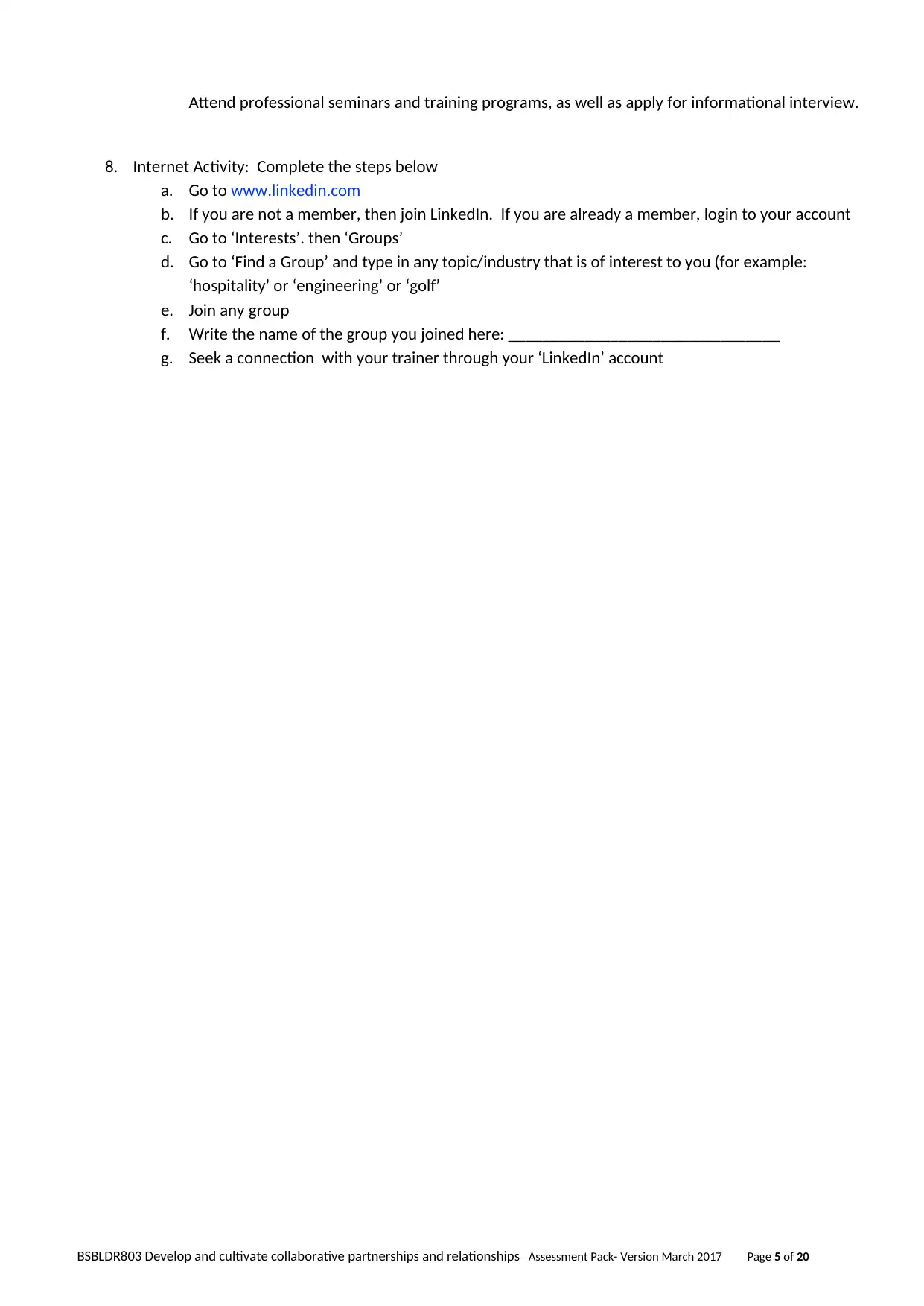
Attend professional seminars and training programs, as well as apply for informational interview.
8. Internet Activity: Complete the steps below
a. Go to www.linkedin.com
b. If you are not a member, then join LinkedIn. If you are already a member, login to your account
c. Go to ‘Interests’. then ‘Groups’
d. Go to ‘Find a Group’ and type in any topic/industry that is of interest to you (for example:
‘hospitality’ or ‘engineering’ or ‘golf’
e. Join any group
f. Write the name of the group you joined here: ________________________________
g. Seek a connection with your trainer through your ‘LinkedIn’ account
BSBLDR803 Develop and cultivate collaborative partnerships and relationships - Assessment Pack- Version March 2017 Page 5 of 20
8. Internet Activity: Complete the steps below
a. Go to www.linkedin.com
b. If you are not a member, then join LinkedIn. If you are already a member, login to your account
c. Go to ‘Interests’. then ‘Groups’
d. Go to ‘Find a Group’ and type in any topic/industry that is of interest to you (for example:
‘hospitality’ or ‘engineering’ or ‘golf’
e. Join any group
f. Write the name of the group you joined here: ________________________________
g. Seek a connection with your trainer through your ‘LinkedIn’ account
BSBLDR803 Develop and cultivate collaborative partnerships and relationships - Assessment Pack- Version March 2017 Page 5 of 20
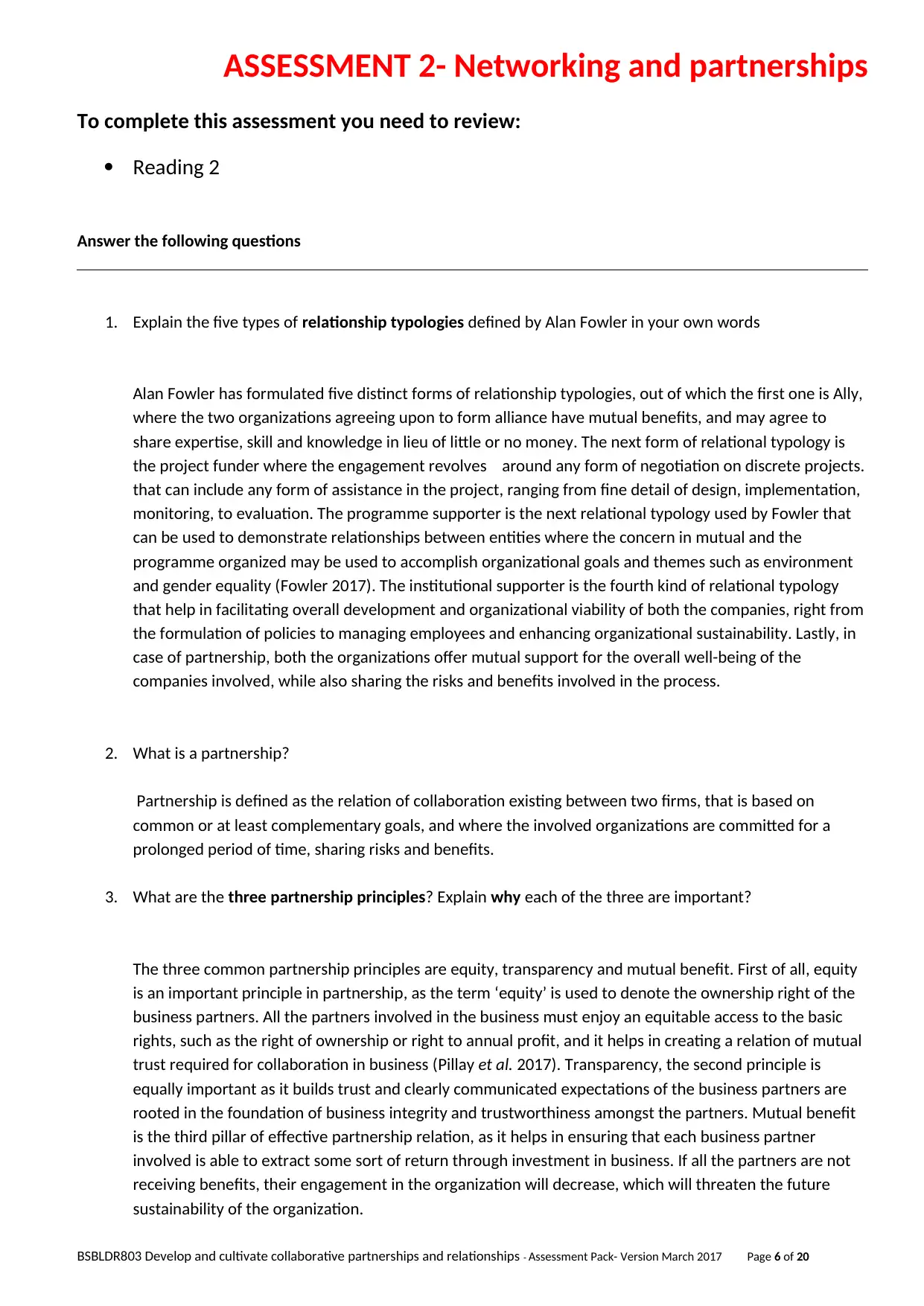
ASSESSMENT 2- Networking and partnerships
To complete this assessment you need to review:
Reading 2
Answer the following questions
1. Explain the five types of relationship typologies defined by Alan Fowler in your own words
Alan Fowler has formulated five distinct forms of relationship typologies, out of which the first one is Ally,
where the two organizations agreeing upon to form alliance have mutual benefits, and may agree to
share expertise, skill and knowledge in lieu of little or no money. The next form of relational typology is
the project funder where the engagement revolves around any form of negotiation on discrete projects.
that can include any form of assistance in the project, ranging from fine detail of design, implementation,
monitoring, to evaluation. The programme supporter is the next relational typology used by Fowler that
can be used to demonstrate relationships between entities where the concern in mutual and the
programme organized may be used to accomplish organizational goals and themes such as environment
and gender equality (Fowler 2017). The institutional supporter is the fourth kind of relational typology
that help in facilitating overall development and organizational viability of both the companies, right from
the formulation of policies to managing employees and enhancing organizational sustainability. Lastly, in
case of partnership, both the organizations offer mutual support for the overall well-being of the
companies involved, while also sharing the risks and benefits involved in the process.
2. What is a partnership?
Partnership is defined as the relation of collaboration existing between two firms, that is based on
common or at least complementary goals, and where the involved organizations are committed for a
prolonged period of time, sharing risks and benefits.
3. What are the three partnership principles? Explain why each of the three are important?
The three common partnership principles are equity, transparency and mutual benefit. First of all, equity
is an important principle in partnership, as the term ‘equity’ is used to denote the ownership right of the
business partners. All the partners involved in the business must enjoy an equitable access to the basic
rights, such as the right of ownership or right to annual profit, and it helps in creating a relation of mutual
trust required for collaboration in business (Pillay et al. 2017). Transparency, the second principle is
equally important as it builds trust and clearly communicated expectations of the business partners are
rooted in the foundation of business integrity and trustworthiness amongst the partners. Mutual benefit
is the third pillar of effective partnership relation, as it helps in ensuring that each business partner
involved is able to extract some sort of return through investment in business. If all the partners are not
receiving benefits, their engagement in the organization will decrease, which will threaten the future
sustainability of the organization.
BSBLDR803 Develop and cultivate collaborative partnerships and relationships - Assessment Pack- Version March 2017 Page 6 of 20
To complete this assessment you need to review:
Reading 2
Answer the following questions
1. Explain the five types of relationship typologies defined by Alan Fowler in your own words
Alan Fowler has formulated five distinct forms of relationship typologies, out of which the first one is Ally,
where the two organizations agreeing upon to form alliance have mutual benefits, and may agree to
share expertise, skill and knowledge in lieu of little or no money. The next form of relational typology is
the project funder where the engagement revolves around any form of negotiation on discrete projects.
that can include any form of assistance in the project, ranging from fine detail of design, implementation,
monitoring, to evaluation. The programme supporter is the next relational typology used by Fowler that
can be used to demonstrate relationships between entities where the concern in mutual and the
programme organized may be used to accomplish organizational goals and themes such as environment
and gender equality (Fowler 2017). The institutional supporter is the fourth kind of relational typology
that help in facilitating overall development and organizational viability of both the companies, right from
the formulation of policies to managing employees and enhancing organizational sustainability. Lastly, in
case of partnership, both the organizations offer mutual support for the overall well-being of the
companies involved, while also sharing the risks and benefits involved in the process.
2. What is a partnership?
Partnership is defined as the relation of collaboration existing between two firms, that is based on
common or at least complementary goals, and where the involved organizations are committed for a
prolonged period of time, sharing risks and benefits.
3. What are the three partnership principles? Explain why each of the three are important?
The three common partnership principles are equity, transparency and mutual benefit. First of all, equity
is an important principle in partnership, as the term ‘equity’ is used to denote the ownership right of the
business partners. All the partners involved in the business must enjoy an equitable access to the basic
rights, such as the right of ownership or right to annual profit, and it helps in creating a relation of mutual
trust required for collaboration in business (Pillay et al. 2017). Transparency, the second principle is
equally important as it builds trust and clearly communicated expectations of the business partners are
rooted in the foundation of business integrity and trustworthiness amongst the partners. Mutual benefit
is the third pillar of effective partnership relation, as it helps in ensuring that each business partner
involved is able to extract some sort of return through investment in business. If all the partners are not
receiving benefits, their engagement in the organization will decrease, which will threaten the future
sustainability of the organization.
BSBLDR803 Develop and cultivate collaborative partnerships and relationships - Assessment Pack- Version March 2017 Page 6 of 20
⊘ This is a preview!⊘
Do you want full access?
Subscribe today to unlock all pages.

Trusted by 1+ million students worldwide
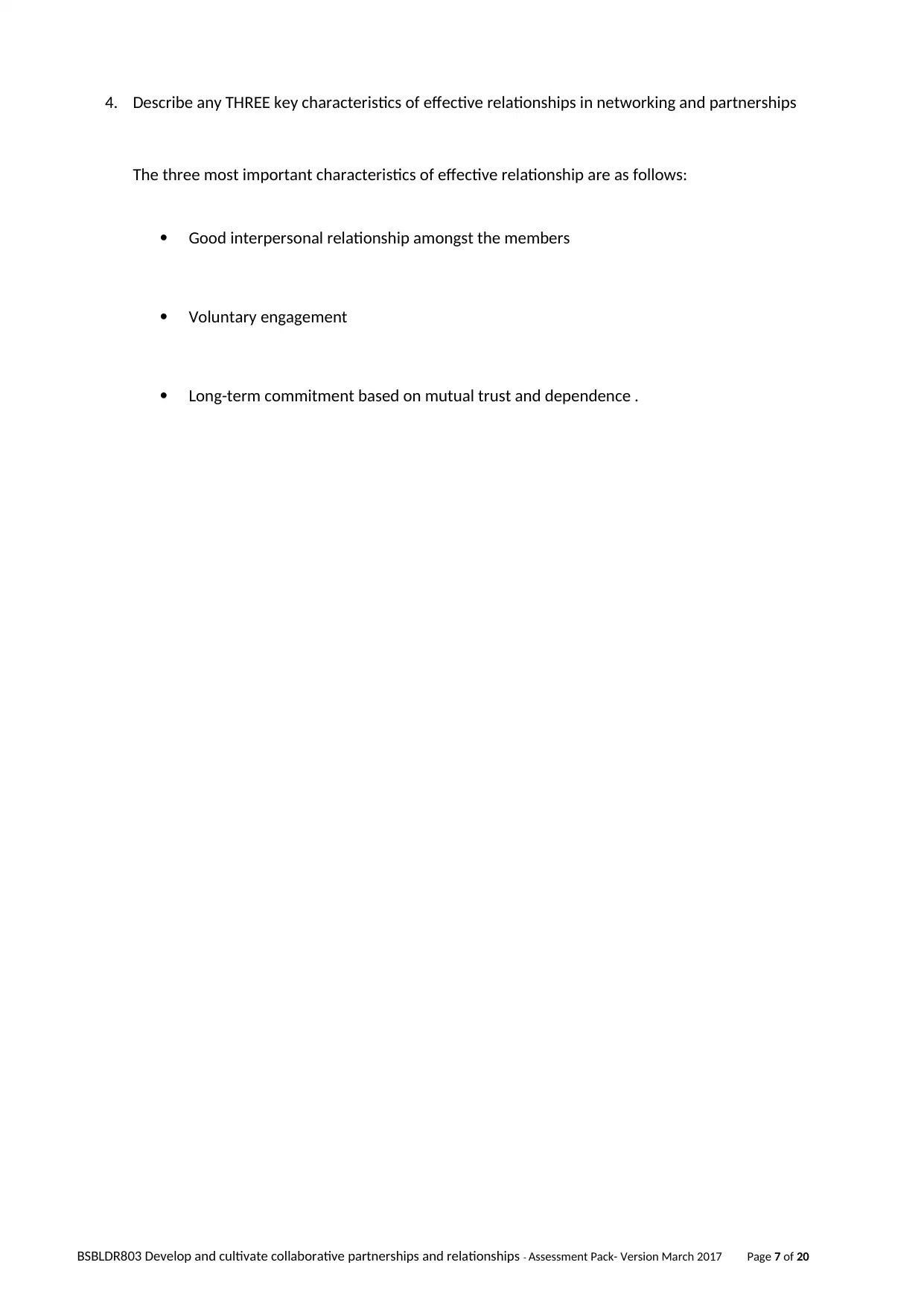
4. Describe any THREE key characteristics of effective relationships in networking and partnerships
The three most important characteristics of effective relationship are as follows:
Good interpersonal relationship amongst the members
Voluntary engagement
Long-term commitment based on mutual trust and dependence .
BSBLDR803 Develop and cultivate collaborative partnerships and relationships - Assessment Pack- Version March 2017 Page 7 of 20
The three most important characteristics of effective relationship are as follows:
Good interpersonal relationship amongst the members
Voluntary engagement
Long-term commitment based on mutual trust and dependence .
BSBLDR803 Develop and cultivate collaborative partnerships and relationships - Assessment Pack- Version March 2017 Page 7 of 20
Paraphrase This Document
Need a fresh take? Get an instant paraphrase of this document with our AI Paraphraser
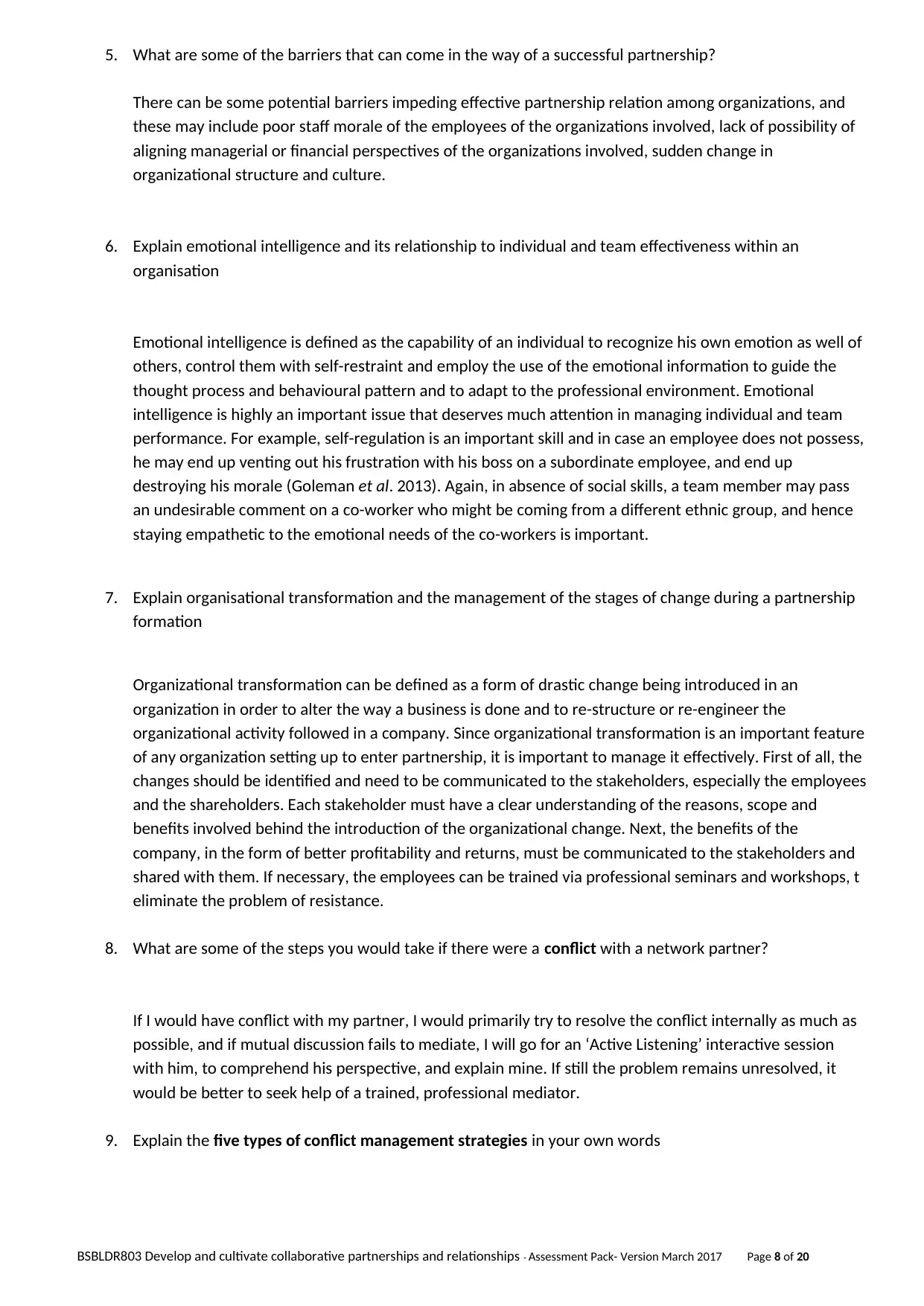
5. What are some of the barriers that can come in the way of a successful partnership?
There can be some potential barriers impeding effective partnership relation among organizations, and
these may include poor staff morale of the employees of the organizations involved, lack of possibility of
aligning managerial or financial perspectives of the organizations involved, sudden change in
organizational structure and culture.
6. Explain emotional intelligence and its relationship to individual and team effectiveness within an
organisation
Emotional intelligence is defined as the capability of an individual to recognize his own emotion as well of
others, control them with self-restraint and employ the use of the emotional information to guide the
thought process and behavioural pattern and to adapt to the professional environment. Emotional
intelligence is highly an important issue that deserves much attention in managing individual and team
performance. For example, self-regulation is an important skill and in case an employee does not possess,
he may end up venting out his frustration with his boss on a subordinate employee, and end up
destroying his morale (Goleman et al. 2013). Again, in absence of social skills, a team member may pass
an undesirable comment on a co-worker who might be coming from a different ethnic group, and hence
staying empathetic to the emotional needs of the co-workers is important.
7. Explain organisational transformation and the management of the stages of change during a partnership
formation
Organizational transformation can be defined as a form of drastic change being introduced in an
organization in order to alter the way a business is done and to re-structure or re-engineer the
organizational activity followed in a company. Since organizational transformation is an important feature
of any organization setting up to enter partnership, it is important to manage it effectively. First of all, the
changes should be identified and need to be communicated to the stakeholders, especially the employees
and the shareholders. Each stakeholder must have a clear understanding of the reasons, scope and
benefits involved behind the introduction of the organizational change. Next, the benefits of the
company, in the form of better profitability and returns, must be communicated to the stakeholders and
shared with them. If necessary, the employees can be trained via professional seminars and workshops, t
eliminate the problem of resistance.
8. What are some of the steps you would take if there were a conflict with a network partner?
If I would have conflict with my partner, I would primarily try to resolve the conflict internally as much as
possible, and if mutual discussion fails to mediate, I will go for an ‘Active Listening’ interactive session
with him, to comprehend his perspective, and explain mine. If still the problem remains unresolved, it
would be better to seek help of a trained, professional mediator.
9. Explain the five types of conflict management strategies in your own words
BSBLDR803 Develop and cultivate collaborative partnerships and relationships - Assessment Pack- Version March 2017 Page 8 of 20
There can be some potential barriers impeding effective partnership relation among organizations, and
these may include poor staff morale of the employees of the organizations involved, lack of possibility of
aligning managerial or financial perspectives of the organizations involved, sudden change in
organizational structure and culture.
6. Explain emotional intelligence and its relationship to individual and team effectiveness within an
organisation
Emotional intelligence is defined as the capability of an individual to recognize his own emotion as well of
others, control them with self-restraint and employ the use of the emotional information to guide the
thought process and behavioural pattern and to adapt to the professional environment. Emotional
intelligence is highly an important issue that deserves much attention in managing individual and team
performance. For example, self-regulation is an important skill and in case an employee does not possess,
he may end up venting out his frustration with his boss on a subordinate employee, and end up
destroying his morale (Goleman et al. 2013). Again, in absence of social skills, a team member may pass
an undesirable comment on a co-worker who might be coming from a different ethnic group, and hence
staying empathetic to the emotional needs of the co-workers is important.
7. Explain organisational transformation and the management of the stages of change during a partnership
formation
Organizational transformation can be defined as a form of drastic change being introduced in an
organization in order to alter the way a business is done and to re-structure or re-engineer the
organizational activity followed in a company. Since organizational transformation is an important feature
of any organization setting up to enter partnership, it is important to manage it effectively. First of all, the
changes should be identified and need to be communicated to the stakeholders, especially the employees
and the shareholders. Each stakeholder must have a clear understanding of the reasons, scope and
benefits involved behind the introduction of the organizational change. Next, the benefits of the
company, in the form of better profitability and returns, must be communicated to the stakeholders and
shared with them. If necessary, the employees can be trained via professional seminars and workshops, t
eliminate the problem of resistance.
8. What are some of the steps you would take if there were a conflict with a network partner?
If I would have conflict with my partner, I would primarily try to resolve the conflict internally as much as
possible, and if mutual discussion fails to mediate, I will go for an ‘Active Listening’ interactive session
with him, to comprehend his perspective, and explain mine. If still the problem remains unresolved, it
would be better to seek help of a trained, professional mediator.
9. Explain the five types of conflict management strategies in your own words
BSBLDR803 Develop and cultivate collaborative partnerships and relationships - Assessment Pack- Version March 2017 Page 8 of 20
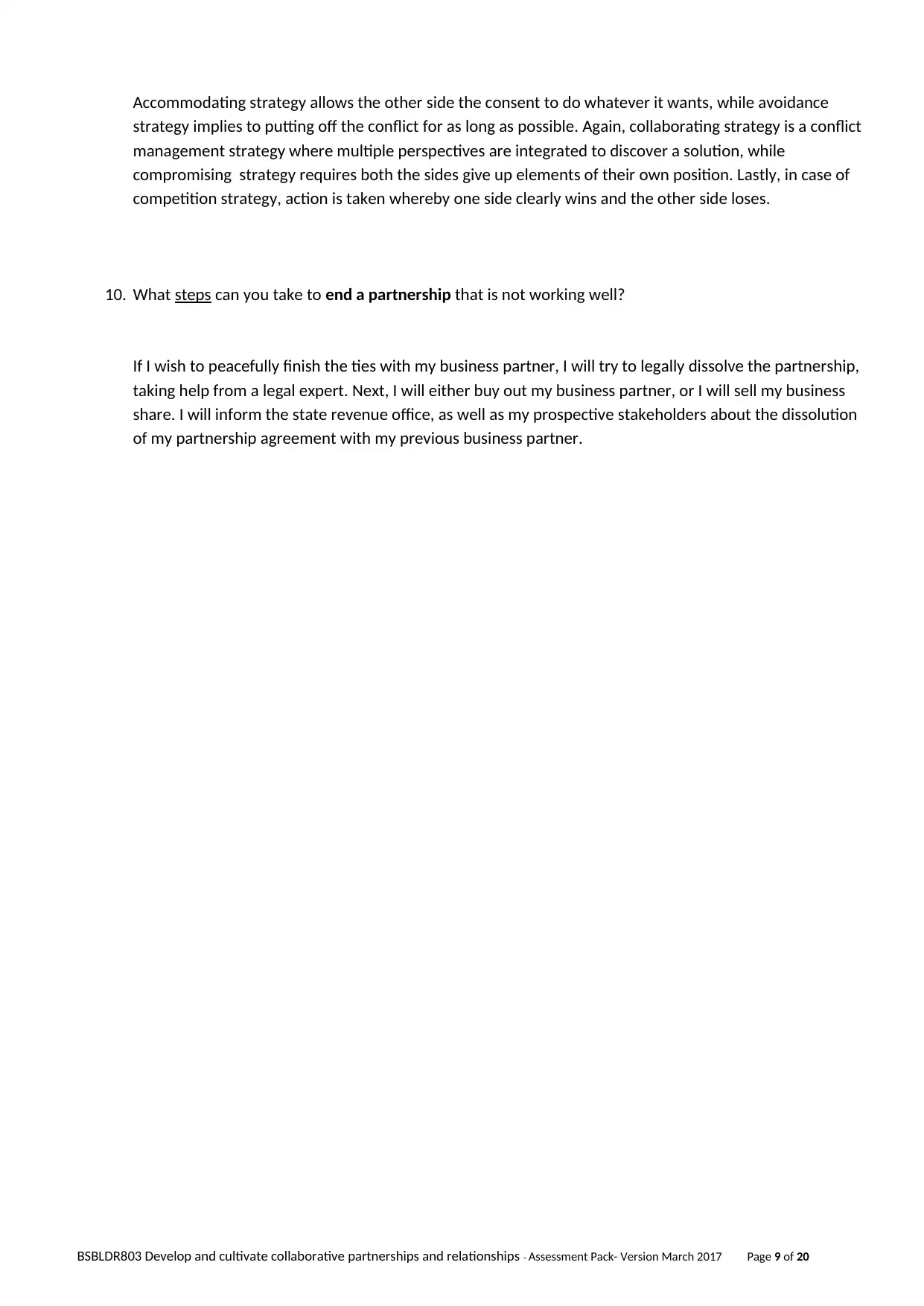
Accommodating strategy allows the other side the consent to do whatever it wants, while avoidance
strategy implies to putting off the conflict for as long as possible. Again, collaborating strategy is a conflict
management strategy where multiple perspectives are integrated to discover a solution, while
compromising strategy requires both the sides give up elements of their own position. Lastly, in case of
competition strategy, action is taken whereby one side clearly wins and the other side loses.
10. What steps can you take to end a partnership that is not working well?
If I wish to peacefully finish the ties with my business partner, I will try to legally dissolve the partnership,
taking help from a legal expert. Next, I will either buy out my business partner, or I will sell my business
share. I will inform the state revenue office, as well as my prospective stakeholders about the dissolution
of my partnership agreement with my previous business partner.
BSBLDR803 Develop and cultivate collaborative partnerships and relationships - Assessment Pack- Version March 2017 Page 9 of 20
strategy implies to putting off the conflict for as long as possible. Again, collaborating strategy is a conflict
management strategy where multiple perspectives are integrated to discover a solution, while
compromising strategy requires both the sides give up elements of their own position. Lastly, in case of
competition strategy, action is taken whereby one side clearly wins and the other side loses.
10. What steps can you take to end a partnership that is not working well?
If I wish to peacefully finish the ties with my business partner, I will try to legally dissolve the partnership,
taking help from a legal expert. Next, I will either buy out my business partner, or I will sell my business
share. I will inform the state revenue office, as well as my prospective stakeholders about the dissolution
of my partnership agreement with my previous business partner.
BSBLDR803 Develop and cultivate collaborative partnerships and relationships - Assessment Pack- Version March 2017 Page 9 of 20
⊘ This is a preview!⊘
Do you want full access?
Subscribe today to unlock all pages.

Trusted by 1+ million students worldwide
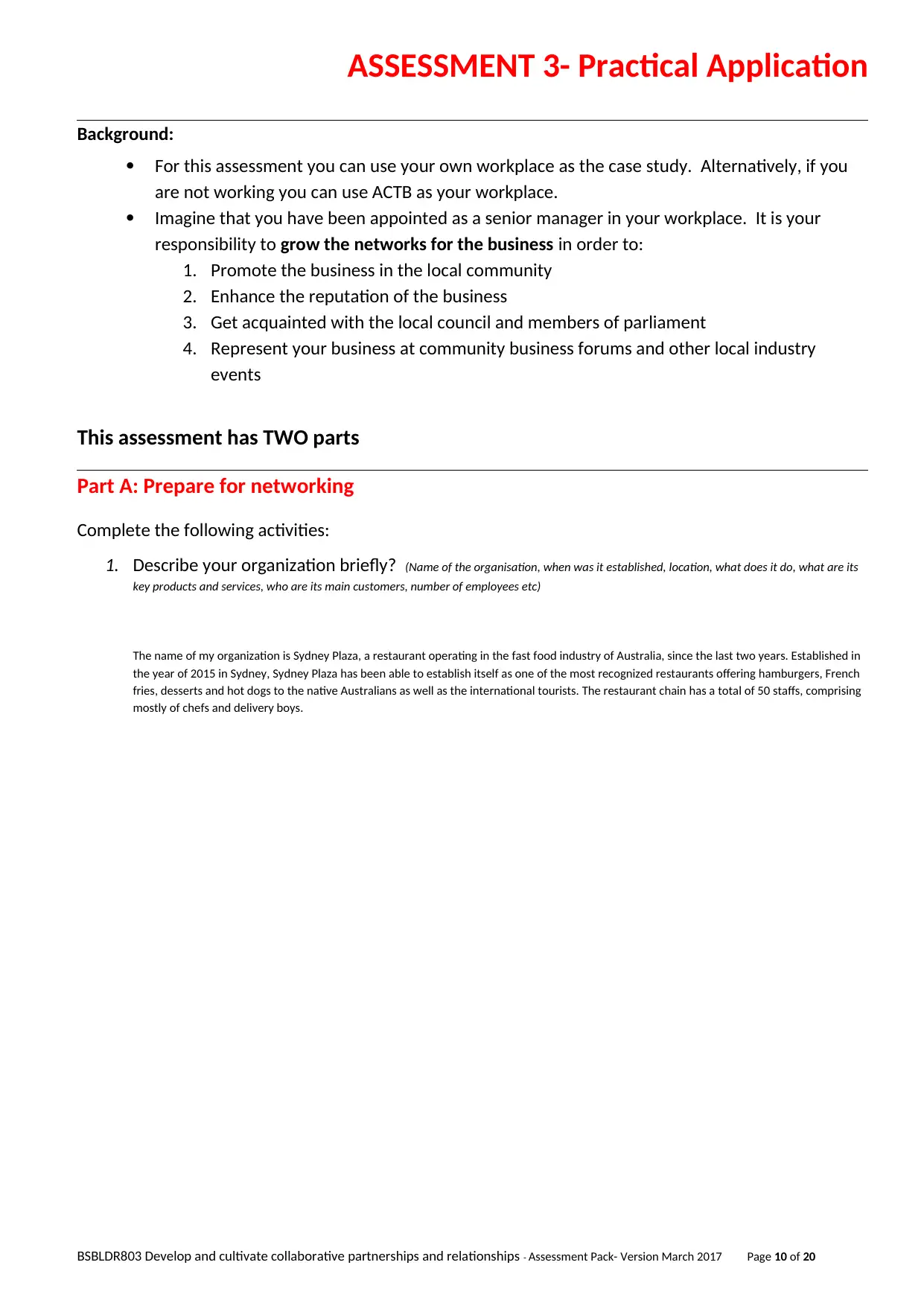
ASSESSMENT 3- Practical Application
Background:
For this assessment you can use your own workplace as the case study. Alternatively, if you
are not working you can use ACTB as your workplace.
Imagine that you have been appointed as a senior manager in your workplace. It is your
responsibility to grow the networks for the business in order to:
1. Promote the business in the local community
2. Enhance the reputation of the business
3. Get acquainted with the local council and members of parliament
4. Represent your business at community business forums and other local industry
events
This assessment has TWO parts
Part A: Prepare for networking
Complete the following activities:
1. Describe your organization briefly? (Name of the organisation, when was it established, location, what does it do, what are its
key products and services, who are its main customers, number of employees etc)
The name of my organization is Sydney Plaza, a restaurant operating in the fast food industry of Australia, since the last two years. Established in
the year of 2015 in Sydney, Sydney Plaza has been able to establish itself as one of the most recognized restaurants offering hamburgers, French
fries, desserts and hot dogs to the native Australians as well as the international tourists. The restaurant chain has a total of 50 staffs, comprising
mostly of chefs and delivery boys.
BSBLDR803 Develop and cultivate collaborative partnerships and relationships - Assessment Pack- Version March 2017 Page 10 of 20
Background:
For this assessment you can use your own workplace as the case study. Alternatively, if you
are not working you can use ACTB as your workplace.
Imagine that you have been appointed as a senior manager in your workplace. It is your
responsibility to grow the networks for the business in order to:
1. Promote the business in the local community
2. Enhance the reputation of the business
3. Get acquainted with the local council and members of parliament
4. Represent your business at community business forums and other local industry
events
This assessment has TWO parts
Part A: Prepare for networking
Complete the following activities:
1. Describe your organization briefly? (Name of the organisation, when was it established, location, what does it do, what are its
key products and services, who are its main customers, number of employees etc)
The name of my organization is Sydney Plaza, a restaurant operating in the fast food industry of Australia, since the last two years. Established in
the year of 2015 in Sydney, Sydney Plaza has been able to establish itself as one of the most recognized restaurants offering hamburgers, French
fries, desserts and hot dogs to the native Australians as well as the international tourists. The restaurant chain has a total of 50 staffs, comprising
mostly of chefs and delivery boys.
BSBLDR803 Develop and cultivate collaborative partnerships and relationships - Assessment Pack- Version March 2017 Page 10 of 20
Paraphrase This Document
Need a fresh take? Get an instant paraphrase of this document with our AI Paraphraser
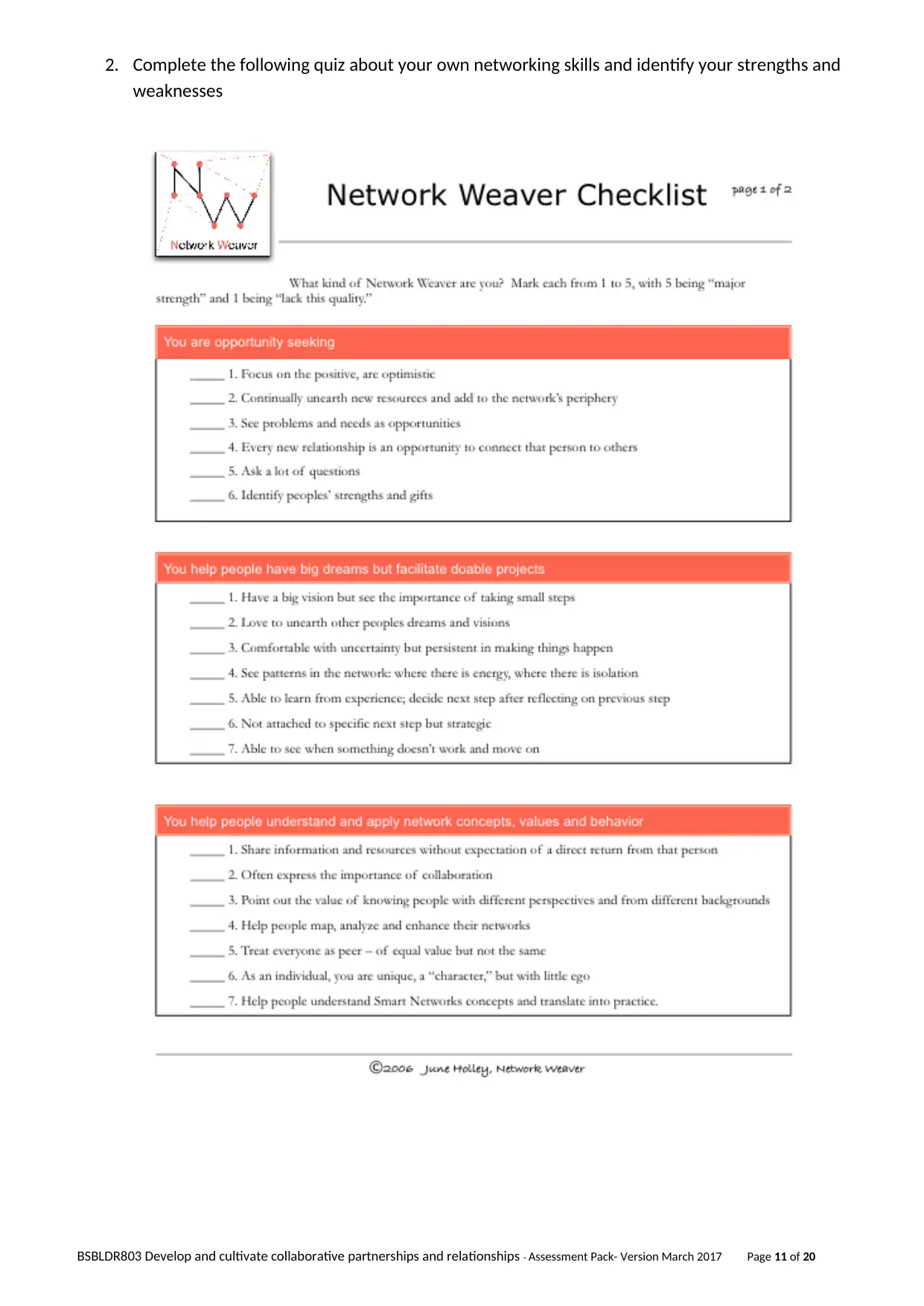
2. Complete the following quiz about your own networking skills and identify your strengths and
weaknesses
BSBLDR803 Develop and cultivate collaborative partnerships and relationships - Assessment Pack- Version March 2017 Page 11 of 20
weaknesses
BSBLDR803 Develop and cultivate collaborative partnerships and relationships - Assessment Pack- Version March 2017 Page 11 of 20
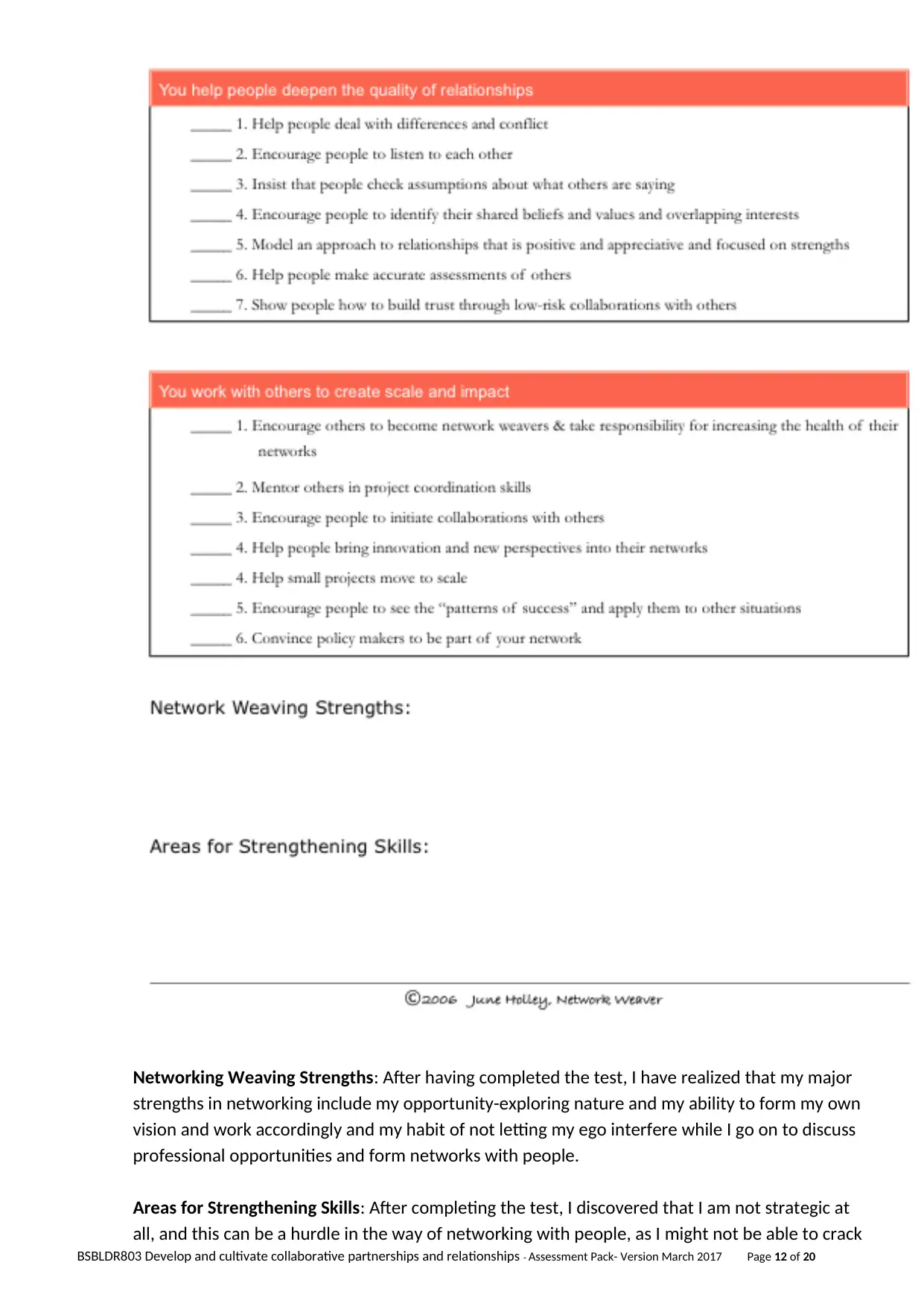
Networking Weaving Strengths: After having completed the test, I have realized that my major
strengths in networking include my opportunity-exploring nature and my ability to form my own
vision and work accordingly and my habit of not letting my ego interfere while I go on to discuss
professional opportunities and form networks with people.
Areas for Strengthening Skills: After completing the test, I discovered that I am not strategic at
all, and this can be a hurdle in the way of networking with people, as I might not be able to crack
BSBLDR803 Develop and cultivate collaborative partnerships and relationships - Assessment Pack- Version March 2017 Page 12 of 20
strengths in networking include my opportunity-exploring nature and my ability to form my own
vision and work accordingly and my habit of not letting my ego interfere while I go on to discuss
professional opportunities and form networks with people.
Areas for Strengthening Skills: After completing the test, I discovered that I am not strategic at
all, and this can be a hurdle in the way of networking with people, as I might not be able to crack
BSBLDR803 Develop and cultivate collaborative partnerships and relationships - Assessment Pack- Version March 2017 Page 12 of 20
⊘ This is a preview!⊘
Do you want full access?
Subscribe today to unlock all pages.

Trusted by 1+ million students worldwide
1 out of 19
Related Documents
Your All-in-One AI-Powered Toolkit for Academic Success.
+13062052269
info@desklib.com
Available 24*7 on WhatsApp / Email
![[object Object]](/_next/static/media/star-bottom.7253800d.svg)
Unlock your academic potential
Copyright © 2020–2025 A2Z Services. All Rights Reserved. Developed and managed by ZUCOL.





